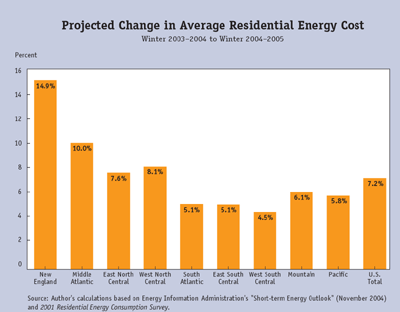Regional Differences in the Impact of Energy Price Increases 
This Public Policy Brief presents estimates of the impact of price increases projected by the U.S. Department of Energy for the winter of 2004-5 on consumers in the nine Census divisions and selected metropolitan areas. It is based on materials presented in a briefing to the President of the Federal Reserve Bank of Boston in December 2004.
Motivation for the Research
The Energy Department forecast that energy prices would be considerably higher in the winter of 2004-5 than in the previous winter. Indeed, in December of 2004, when this analysis was prepared, some prices were already noticeably higher. The department forecast especially large increases for heating oil, a fuel used much more extensively in New England than elsewhere in the country. Gasoline costs were also considerably higher than a year earlier, and driving costs loom larger in the market baskets of consumers outside the Northeast, on average. This brief estimates the impact of the Energy Department's projected energy price increases on consumers in the nine Census divisions and selected metropolitan areas.
Research Approach
The estimates are based on the fuel mix used for heating and other residential energy use (lighting, water heating, air conditioning, appliances, etc.) across the nine Census divisions, the relative importance of home energy use and motor fuel use in each area's consumer market basket, and the fuel price increases projected by the Energy Department.
Key Findings
- Because of New England's heavy dependence on heating oil, the fuel facing the sharpest projected price increase, New England's residential energy costs were expected to rise the fastest among the nine Census divisions-almost 15 percent from the previous winter.
- The next highest projected increase was in the Mid-Atlantic states, where heating oil is used by one-quarter of households and amounts to 10 percent of residential energy expenditure; the resulting projected average price increase for residential energy was 10 percent, while the projected national average increase in residential energy costs was 7.2 percent.
- The Boston metro area, which includes parts of Connecticut and New Hampshire as well as eastern Massachusetts, suffered the biggest projected hit to non-shelter, non-fuel consumption, totaling a 2.4 percent decline.
Implications
Changes in spending required by energy price increases in the winter of 2004-5, while not huge, could still represent a noticeable hit to consumers' budgets. Furthermore, since the calculations yield average effects, some households in each region or metro area will face much larger increases in costs, and some, much smaller, depending on the individual fuels used and energy's share of the budget of each household.
Since U.S. manufacturers and other producers also use various fuels, increases in energy prices could have differential regional effects on employment, depending on the relative importance of energy-dependent industries. In addition, regions that produce oil and natural gas benefit from price increases on the production side, even as their consumers face higher fuel bills. However, since much of oil and natural gas consumed within the country is imported, a substantial share of the blow to U.S. consumer and producer budgets is not balanced by increases in domestic income.


 About the Authors
About the Authors
Katharine Bradbury



